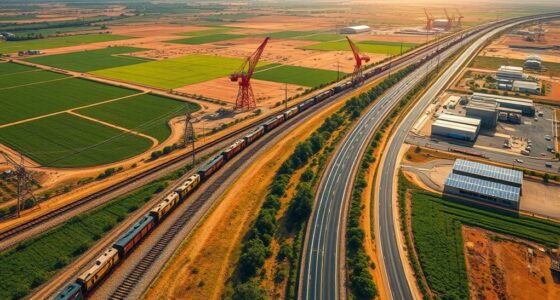By 2025, you’ll benefit from fintech innovations that make getting credit faster and more personalized, helping your business grow quickly. Operational costs will decrease thanks to automation and smarter financial management tools, giving you more confidence to take risks. Supply chain tech and digital logistics will boost efficiency and resilience, ensuring smoother operations. Stay tuned—there’s more about how these breakthroughs can transform your small business ahead.
Key Takeaways
- Fintech innovations enable fast, personalized credit decisions, improving access to funding for small businesses.
- Real-time financial insights and digital tools enhance cash flow management and strategic planning.
- Supply chain digitization using IoT and analytics reduces costs and improves visibility and resilience.
- Autonomous delivery methods lower logistics costs and increase market reach and flexibility.
- Increased transparency and data-driven strategies boost business confidence and competitive advantage.

What will small businesses look like in 2025? You’re likely to see a landscape transformed by rapid fintech innovation and streamlined supply chains. Technology continues to reshape how you operate, making financial services more accessible and efficient than ever. With fintech innovation, you can now access faster, more personalized credit options without the lengthy approval processes of traditional lenders. Digital platforms and AI-driven algorithms analyze your business data in real-time, giving you quicker insights into your creditworthiness. This means you won’t have to wait weeks for funding; instead, you’ll get the capital you need to grow, right when you need it. Additionally, fintech solutions are reducing costs by automating routine financial tasks, helping you manage cash flow more effectively. You’ll also find that digital payment systems and mobile banking are seamlessly integrated into your daily operations, enhancing customer experience and reducing transaction costs. As a small business owner, you’ll benefit from these innovations by having access to a broader range of financial products tailored to your specific needs, ultimately boosting your confidence to take calculated risks and expand. Furthermore, AI in Business is playing a growing role in automating decision-making processes and providing deeper insights, enabling you to make more informed strategic choices.
The supply chain will be equally revolutionized by technology, making your operations more resilient and flexible. Advanced supply chain management tools, powered by data analytics and IoT, will give you real-time insights into inventory levels, supplier performance, and delivery schedules. This means fewer surprises and better planning, so you can respond swiftly to market changes. Automation and digital tracking reduce delays and errors, helping you cut costs and improve efficiency. You’ll also have more visibility into your supply chain, enabling you to identify potential disruptions early and adapt accordingly. This transparency builds confidence, letting you plan for growth with a clearer picture of your resources. Furthermore, innovative logistics solutions, such as drone deliveries and autonomous vehicles, are becoming more accessible, lowering transportation costs and expanding your reach to new markets. As these supply chain innovations integrate with your existing systems, you’ll be able to optimize your procurement and distribution processes, ultimately reducing expenses and increasing your competitive edge. All these technological advancements mean you’re better equipped to handle uncertainties, giving you confidence in your business’s future.
Frequently Asked Questions
How Will Remote Work Impact Small Business Growth in 2025?
Remote work will boost your small business growth in 2025 by enabling remote collaboration and attracting digital nomads. You’ll find it easier to access talent worldwide, reduce overhead costs, and expand your customer base online. Embracing these trends helps you stay competitive, innovate faster, and build a flexible work environment. As remote work becomes more mainstream, your business can thrive by adapting to this new, dynamic landscape.
What New Technologies Will Small Businesses Adopt by 2025?
By 2025, you’ll adopt AI automation to streamline operations and improve customer service, making your business more efficient. Blockchain integration will also become essential for secure transactions and transparent supply chains. These technologies will help you reduce costs, enhance trust, and stay competitive in a rapidly evolving market. Embracing AI and blockchain now positions your small business for sustainable growth and innovation in the coming years.
How Might Government Policies Evolve to Support Small Businesses?
You’ll see government policies evolving with more incentives and streamlined regulatory reforms to support small businesses. Currently, over 60% of small businesses say policy changes impact their growth positively. Expect increased government incentives for innovation, digital adoption, and sustainable practices. Regulatory reforms will likely reduce compliance costs and simplify processes, making it easier for you to navigate permits and taxes, giving you greater confidence to expand and adapt in the changing economy.
What Emerging Markets Present Opportunities for Small Business Expansion?
Emerging markets like Southeast Asia, Africa, and Latin America offer great opportunities for your small business’s global expansion. These regions have growing consumer bases, rising middle classes, and increasing demand for innovative products and services. By tapping into emerging markets, you can diversify your revenue streams, build new partnerships, and gain a competitive edge. Keep an eye on local regulations, cultural nuances, and infrastructure to guarantee successful expansion.
How Will Consumer Behavior Shifts Influence Small Business Strategies?
Imagine a bustling marketplace where consumer confidence soars alongside shifting purchasing habits. You’ll need to adapt your small business strategies to keep pace with these changes. As consumers become more selective and value-driven, you must tailor your offerings and marketing efforts. By understanding these shifts, you can build trust and loyalty, turning evolving behaviors into opportunities for growth and innovation in your business landscape.
Conclusion
By 2025, your small business will navigate tighter credit markets, rising costs, and shifting confidence levels. Remember, over 60% of small businesses report feeling more optimistic about growth prospects, even amid challenges. Staying adaptable and informed will be key to thriving. Embrace these changes, and you’ll be better prepared to turn hurdles into opportunities, ensuring your business not only survives but flourishes in the evolving landscape of 2025.








